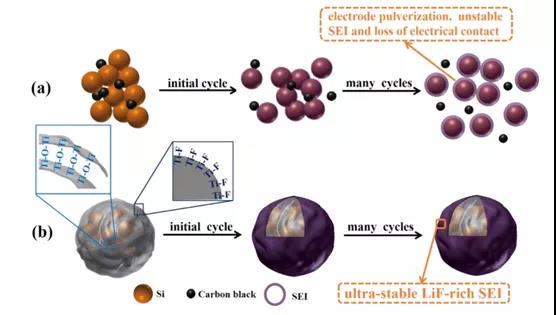
【Research Background】
In order to meet the growing energy density needs of portable electronic products and electric vehicles, electrode materials with high capacity and suitable operating voltage are being explored for the next generation of lithium ion batteries (LIB). Among the negative candidate materials, silicon is considered to be one of the most promising materials because of its high theoretical specific capacity (4200 mA hg –1 ) and relatively low operating voltage (<0.5 Vvs Li / Li + ). However, the huge volume change (about 300%) generated during the deep layer lithiation / delithiation process leads to severe particle cracking and unstable solid-electrolyte mesophase (SEI) layer. Business applications. In order to solve the inherent unstable characteristics of silicon SEI, there is an urgent need for fine design of artificial SEI layers based on Si negative electrodes.
Due to its unique electrochemical and mechanical properties, LiF is currently considered to be the most effective SEI component for battery anodes. Since LiF has the largest band gap (13.6 eV) and the lowest electronic conductivity, it can suppress electron tunneling during electrochemical cycling. The large number of fluorine groups in MXene nanosheets is expected to form a highly conformal, uniform and durable LiF-rich layer on the surface of MXene during cycling. Combining the above advantages, the LiF-rich SEI layer from MXene will become an ideal artificial SEI candidate material for Si-based negative electrodes.
【Achievement Introduction】
Recently, the research group of Professor Xiaowei Yang of Tongji University published an article in the internationally renowned academic journal ACS Applied Materials & Interfaces : MXene Frameworks Promote the Growth and Stability of LiF-Rich Solid − Electrolyte Interphases on Silicon Nanoparticle Bundles . Research and design and prepare a stable protective interface on a silicon anode under a strong MXene frame (Si @ MXene capsule), in which the silicon nanoparticle bundle is encapsulated in the MXene frame, which has shrinkage formed by capillary forces Microstructure, repeated volume changes of silicon nanoparticles during the charge / discharge cycle, through a simple thermal self-crosslinking process, a large number of covalent bonds (Ti-O-Ti) are introduced between adjacent nanosheets, Greatly improve the structural stability of the MXene frame, thereby achieving a highly stable electrode structure.
【Graphic introduction】

Figure 1. Schematic diagram of a silicon-based anode with and without a protective MXene casing during cycling

Figure 2. Physical characterization of Si @ MXene capsules

Figure 3. XPS spectrum and N 2 adsorption / desorption isotherms of Si @ MXene capsules

Figure 4. XRD pattern of the corresponding sample

Figure 5. Electrochemical performance of Si @ MXene electrode

Figure 6. XPS spectrum of Si @ MXene electrode after different cycle times of 1 A g -1

Figure 7. SEM images of silicon-based electrodes before and after cycling
【Summary of this article】
This paper proposes a reasonable method to design a highly stable protective phase on the silicon anode. The wrinkled MXene nanosheets have enough free volume to buffer the stress caused by the silicon anode, and the formation of covalent bonds between adjacent sheets helps to build a strong MXene skeleton. In addition, the rich fluorine groups in MXene will produce a highly dense and long-lasting LiF-rich SEI layer on the casing during circulation, which can suppress the decomposition of the organic electrolyte. Thanks to these advantages, the obtained anode can provide a high specific capacity of 1797 mA hg –1 at 0.2 A g –1 , a capacity retention rate of up to 86.7% after 500 cycles at 2 A g –1 , and an average coulombic efficiency 99.6%. More importantly, the design strategy for building a LiF-rich SEI layer on a silicon anode can also be applied to other high-capacity electrode materials with high volume effects.
Literature link:
https://dx.doi.org/10.1021/acsami.0c01959
Source: MXene Frontier
This information originates from the Internet for academic exchange only. If there is any infringement, please contact us to delete it immediately











